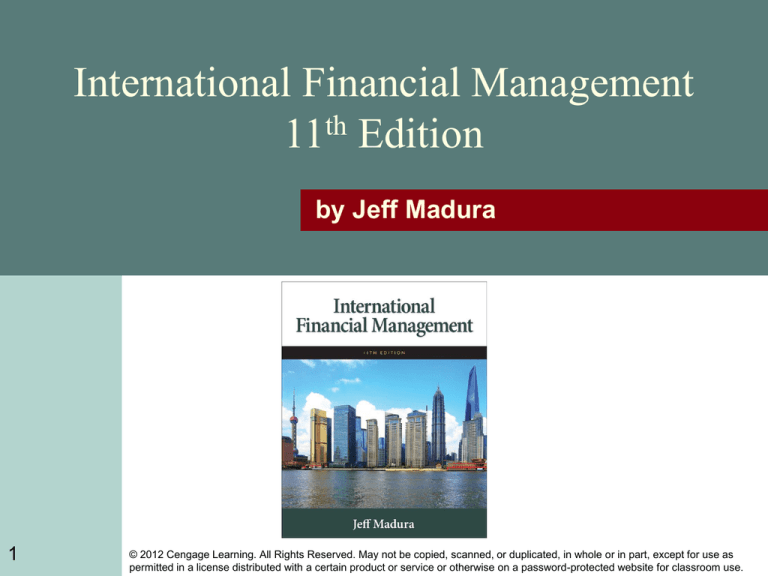
International Financial Management
11th Edition
by Jeff Madura
1
© 2012 Cengage Learning. All Rights Reserved. May not be copied, scanned, or duplicated, in whole or in part, except for use as
permitted in a license distributed with a certain product or service or otherwise on a password-protected website for classroom use.
11 Managing Transaction Exposure
Chapter Objectives
Compare the techniques commonly used to hedge
payables
Compare the techniques commonly used to hedge
receivables
Describe limitations of hedging
Suggest other methods of reducing exchange rate risk
when hedging techniques are not available
2
© 2012 Cengage Learning. All Rights Reserved. May not be copied, scanned, or duplicated, in whole or in part, except for use as
permitted in a license distributed with a certain product or service or otherwise on a password-protected website for classroom use.
Policies for Hedging Transaction Exposure
Hedging Most of the Exposure
Hedging most of the transaction exposure allows MNCs to
more accurately forecast future cash flows (in their home
currency) so that they can make better decisions regarding the
amount of financing they will need.
Selective Hedging
3
MNC must identify its degree of transaction exposure.
MNC must consider the various techniques to hedge the
exposure so that it can decide which hedging technique is
optimal and whether to hedge its transaction exposure.
© 2012 Cengage Learning. All Rights Reserved. May not be copied, scanned, or duplicated, in whole or in part, except for use as
permitted in a license distributed with a certain product or service or otherwise on a password-protected website for classroom use.
Hedging Exposure to Payables
An MNC may decide to hedge part or all of its
known payables transactions using:
4
Futures hedge
Forward hedge
Money market hedge
Currency option hedge
© 2012 Cengage Learning. All Rights Reserved. May not be copied, scanned, or duplicated, in whole or in part, except for use as
permitted in a license distributed with a certain product or service or otherwise on a password-protected website for classroom use.
Forward or Futures Hedge on Payables
Allows an MNC to lock in a specific exchange rate at which it
can purchase a currency and hedge payables. A forward
contract is negotiated between the firm and a financial
institution. The contract will specify the:
currency that the firm will pay
currency that the firm will receive
amount of currency to be received by the firm
rate at which the MNC will exchange currencies (called
the forward rate)
future date at which the exchange of currencies will
occur
5
© 2012 Cengage Learning. All Rights Reserved. May not be copied, scanned, or duplicated, in whole or in part, except for use as
permitted in a license distributed with a certain product or service or otherwise on a password-protected website for classroom use.
Money Market Hedge on Payables
Involves taking a money market position to cover
a future payables position.
If a firm prefers to hedge payables without using
its cash balances, then it must
Borrow funds in the home currency and
Invest in a short-term instrument in the foreign
currency
6
© 2012 Cengage Learning. All Rights Reserved. May not be copied, scanned, or duplicated, in whole or in part, except for use as
permitted in a license distributed with a certain product or service or otherwise on a password-protected website for classroom use.
Call Option Hedge on Payables
A currency call option provides the right to buy a
specified amount of a particular currency at a
specified strike price or exercise price within a
given period of time.
The currency call option does not obligate its
owner to buy the currency at that price. The MNC
has the flexibility to let the option expire and
obtain the currency at the existing spot rate when
payables are due.
7
© 2012 Cengage Learning. All Rights Reserved. May not be copied, scanned, or duplicated, in whole or in part, except for use as
permitted in a license distributed with a certain product or service or otherwise on a password-protected website for classroom use.
Cost of Call Options
Based on contingency graph (Exhibit 11.1)
Advantage: provides an effective hedge
Disadvantage: premium must be paid
Based on currency forecast (Exhibit 11.2)
MNC can incorporate forecasts of the spot rate to more
accurately estimate the cost of hedging with call options.
Consideration of Alternative Call Options
Several different types of call options may be available, with
different exercise prices and premiums for a given currency and
expiration date.
Whatever call option is perceived to be most desirable for
hedging a particular payables position would be analyzed, so that
it could then be compared to the other hedging techniques.
8
© 2012 Cengage Learning. All Rights Reserved. May not be copied, scanned, or duplicated, in whole or in part, except for use as
permitted in a license distributed with a certain product or service or otherwise on a password-protected website for classroom use.
Exhibit 11.1 Contingency Graph for Hedging Payables With
Call Options
9
© 2012 Cengage Learning. All Rights Reserved. May not be copied, scanned, or duplicated, in whole or in part, except for use as
permitted in a license distributed with a certain product or service or otherwise on a password-protected website for classroom use.
Exhibit 11.2 Use of Currency Call Options for Hedging Euro
Payables (Exercise Price = $1.20, Premium = $.03)
10
© 2012 Cengage Learning. All Rights Reserved. May not be copied, scanned, or duplicated, in whole or in part, except for use as
permitted in a license distributed with a certain product or service or otherwise on a password-protected website for classroom use.
Comparison of Techniques to Hedge Payables
The cost of the forward hedge or money
market hedge can be determined with
certainty
The currency call option hedge has different
outcomes depending on the future spot rate at
the time payables are due.
11
© 2012 Cengage Learning. All Rights Reserved. May not be copied, scanned, or duplicated, in whole or in part, except for use as
permitted in a license distributed with a certain product or service or otherwise on a password-protected website for classroom use.
Exhibit 11.3 Comparison of Hedging Alternatives for
Coleman Co.
12
© 2012 Cengage Learning. All Rights Reserved. May not be copied, scanned, or duplicated, in whole or in part, except for use as
permitted in a license distributed with a certain product or service or otherwise on a password-protected website for classroom use.
Optimal Technique for Hedging Payables
1. Select optimal hedging technique by:
a. Consider whether futures or forwards are preferred.
b. Consider desirability of money market hedge versus
futures/forwards based on cost.
c. Assess the feasibility of a currency call option based on
estimated cash outflows.
2. Choose optimal hedge versus no hedge for payables
a. Even when an MNC knows what its future payables will be,
it may decide not to hedge in some cases.
3. Evaluate the hedge decision by estimating the real
cost of hedging versus the cost if not hedged.
13
© 2012 Cengage Learning. All Rights Reserved. May not be copied, scanned, or duplicated, in whole or in part, except for use as
permitted in a license distributed with a certain product or service or otherwise on a password-protected website for classroom use.
Exhibit 11.4 Graphic Comparison of Techniques to
Hedge Payables
14
© 2012 Cengage Learning. All Rights Reserved. May not be copied, scanned, or duplicated, in whole or in part, except for use as
permitted in a license distributed with a certain product or service or otherwise on a password-protected website for classroom use.
Hedging Exposure to Receivables
1. Forward or futures hedge allows the MNC to lock in
the exchange rate at which it can sell a specific
currency.
2. Money market hedge involves borrowing the
currency that will be received and using the
receivables to pay off the loan.
3. Put option hedge on receivables provides the right
to sell a specified amount of a particular currency at
a specified strike price by a specified expiration
date.
15
© 2012 Cengage Learning. All Rights Reserved. May not be copied, scanned, or duplicated, in whole or in part, except for use as
permitted in a license distributed with a certain product or service or otherwise on a password-protected website for classroom use.
Cost of Put Options
1. Based on Contingency Graph (Exhibit 11.5)
a. Advantage: provides an effective hedge
b. Disadvantage: premium must be paid
2. Based on Currency Forecasts (Exhibit 11.6)
a. MNC can use currency forecasts to more
accurately estimate the dollar cash inflows to be
received when hedging with put options.
16
© 2012 Cengage Learning. All Rights Reserved. May not be copied, scanned, or duplicated, in whole or in part, except for use as
permitted in a license distributed with a certain product or service or otherwise on a password-protected website for classroom use.
Exhibit 11.5 Contingency Graph for Hedging Receivables with
Put Options
17
© 2012 Cengage Learning. All Rights Reserved. May not be copied, scanned, or duplicated, in whole or in part, except for use as
permitted in a license distributed with a certain product or service or otherwise on a password-protected website for classroom use.
Exhibit 11.6 Use of Currency Put Options for Hedging Swiss
Franc Receivables (Exercise Price = $.72; Premium = $.02)
18
© 2012 Cengage Learning. All Rights Reserved. May not be copied, scanned, or duplicated, in whole or in part, except for use as
permitted in a license distributed with a certain product or service or otherwise on a password-protected website for classroom use.
Comparison of Techniques for Hedging Receivables
1. Optimal Technique for Hedging Receivables:
a. Consider whether futures or forwards are preferred.
b. Consider desirability of money market hedge versus
futures/forwards based on cost.
c. Assess the feasibility of a currency put option based on
estimated cash outflows.
2. Choose optimal hedge versus no hedge for
receivables
3. Evaluate the hedge decision by estimating the real
cost of hedging receivables versus the cost of
receivables if not hedged.
19
© 2012 Cengage Learning. All Rights Reserved. May not be copied, scanned, or duplicated, in whole or in part, except for use as
permitted in a license distributed with a certain product or service or otherwise on a password-protected website for classroom use.
Exhibit 11.7 Comparison of Hedging Alternatives for Viner Co.
20
© 2012 Cengage Learning. All Rights Reserved. May not be copied, scanned, or duplicated, in whole or in part, except for use as
permitted in a license distributed with a certain product or service or otherwise on a password-protected website for classroom use.
Exhibit 11.8 Graph Comparison of Techniques to Hedge
Receivables
21
© 2012 Cengage Learning. All Rights Reserved. May not be copied, scanned, or duplicated, in whole or in part, except for use as
permitted in a license distributed with a certain product or service or otherwise on a password-protected website for classroom use.
Exhibit 11.9 Review of Techniques for Hedging Transaction
Exposure
22
© 2012 Cengage Learning. All Rights Reserved. May not be copied, scanned, or duplicated, in whole or in part, except for use as
permitted in a license distributed with a certain product or service or otherwise on a password-protected website for classroom use.
Limitations of Hedging
Limitation of Hedging an Uncertain Payment
Some international transactions involve an uncertain
amount of foreign currency, leading to overhedging.
Limitation of Repeated Short-Term Hedging
The continual short-term hedging of repeated
transactions may have limited effectiveness.
Long-term Hedging as a Solution
Some banks offer forward contracts for up to 5 years or
10 years on some commonly traded currencies.
23
© 2012 Cengage Learning. All Rights Reserved. May not be copied, scanned, or duplicated, in whole or in part, except for use as
permitted in a license distributed with a certain product or service or otherwise on a password-protected website for classroom use.
Exhibit 11.10 Illustration of Repeated Hedging of Foreign
Payables When the Foreign Currency Is Appreciating
24
© 2012 Cengage Learning. All Rights Reserved. May not be copied, scanned, or duplicated, in whole or in part, except for use as
permitted in a license distributed with a certain product or service or otherwise on a password-protected website for classroom use.
Exhibit 11.11 Long-Term Hedging of Payables When the
Foreign Currency Is Appreciating
25
© 2012 Cengage Learning. All Rights Reserved. May not be copied, scanned, or duplicated, in whole or in part, except for use as
permitted in a license distributed with a certain product or service or otherwise on a password-protected website for classroom use.
Alternative Hedging Techniques
Leading and Lagging: adjusting the timing of a
payment or disbursement to reflect expectations about
future currency movements.
Cross-Hedging: hedging by using a currency that
serves as a proxy for the currency in which the MNC
is exposed.
Currency Diversification: reduce exposure by
diversifying business among numerous countries.
26
© 2012 Cengage Learning. All Rights Reserved. May not be copied, scanned, or duplicated, in whole or in part, except for use as
permitted in a license distributed with a certain product or service or otherwise on a password-protected website for classroom use.
SUMMARY
An MNC may choose to hedge most of its transaction
exposure or to selectively hedge. Some MNCs hedge most of
their transaction exposure so that they can more accurately
predict their future cash inflows or outflows and make better
decisions regarding the amount of financing they will need.
Many MNCs use selective hedging, in which they consider
each type of transaction separately.
To hedge payables, a futures or forward contract on the
foreign currency can be purchased. Alternatively, a money
market hedge strategy can be used; in this case, the MNC
borrows its home currency and converts the proceeds into the
foreign currency that will be needed in the future. Finally, call
options on the foreign currency can be purchased.
27
© 2012 Cengage Learning. All Rights Reserved. May not be copied, scanned, or duplicated, in whole or in part, except for use as
permitted in a license distributed with a certain product or service or otherwise on a password-protected website for classroom use.
SUMMARY (Cont.)
To hedge receivables, a futures or forward contract on the
foreign currency can be sold. Alternatively, a money market
hedge strategy can be used. In this case, the MNC borrows the
foreign currency to be received and converts the funds into its
home currency; the loan is to be repaid by the receivables.
Finally, put options on the foreign currency can be purchased.
When hedging techniques are not available, there are still
some methods of reducing transaction exposure, such as
leading and lagging, cross-hedging, and currency
diversification.
28
© 2012 Cengage Learning. All Rights Reserved. May not be copied, scanned, or duplicated, in whole or in part, except for use as
permitted in a license distributed with a certain product or service or otherwise on a password-protected website for classroom use.
SUMMARY (Cont.)
The currency options hedge has an advantage over the other
hedging techniques in that the options do not have to be
exercised if the MNC would be better off unhedged. A
premium must be paid to purchase the currency options,
however, so there is a cost for the flexibility they provide.
One limitation of hedging is that if the actual payment on a
transaction is less than the expected payment, the MNC
overhedged and is partially exposed to exchange rate
movements.
29
© 2012 Cengage Learning. All Rights Reserved. May not be copied, scanned, or duplicated, in whole or in part, except for use as
permitted in a license distributed with a certain product or service or otherwise on a password-protected website for classroom use.
SUMMARY (Cont.)
Alternatively, if an MNC hedges only the minimum possible
payment in the transaction, it will be partially exposed to
exchange rate movements if the transaction involves a
payment that exceeds the minimum. Another limitation of
hedging is that a short-term hedge is only effective for the
period in which it was applied. One potential solution to this
limitation is for an MNC to use long-term hedging rather than
repeated short-term hedging. This choice is more effective if
the MNC can be sure that its transaction exposure will persist
into the distant future.
30
© 2012 Cengage Learning. All Rights Reserved. May not be copied, scanned, or duplicated, in whole or in part, except for use as
permitted in a license distributed with a certain product or service or otherwise on a password-protected website for classroom use.








